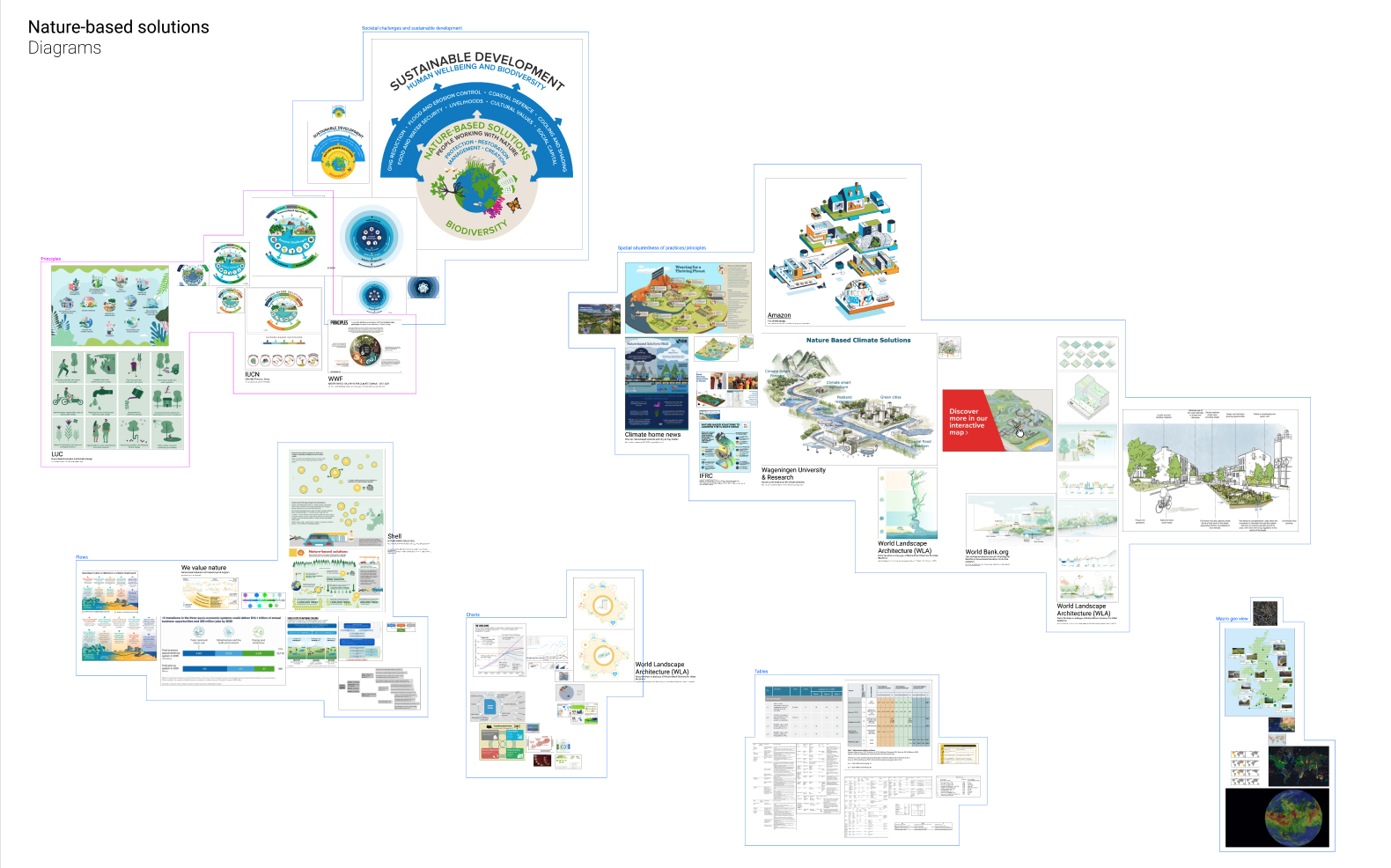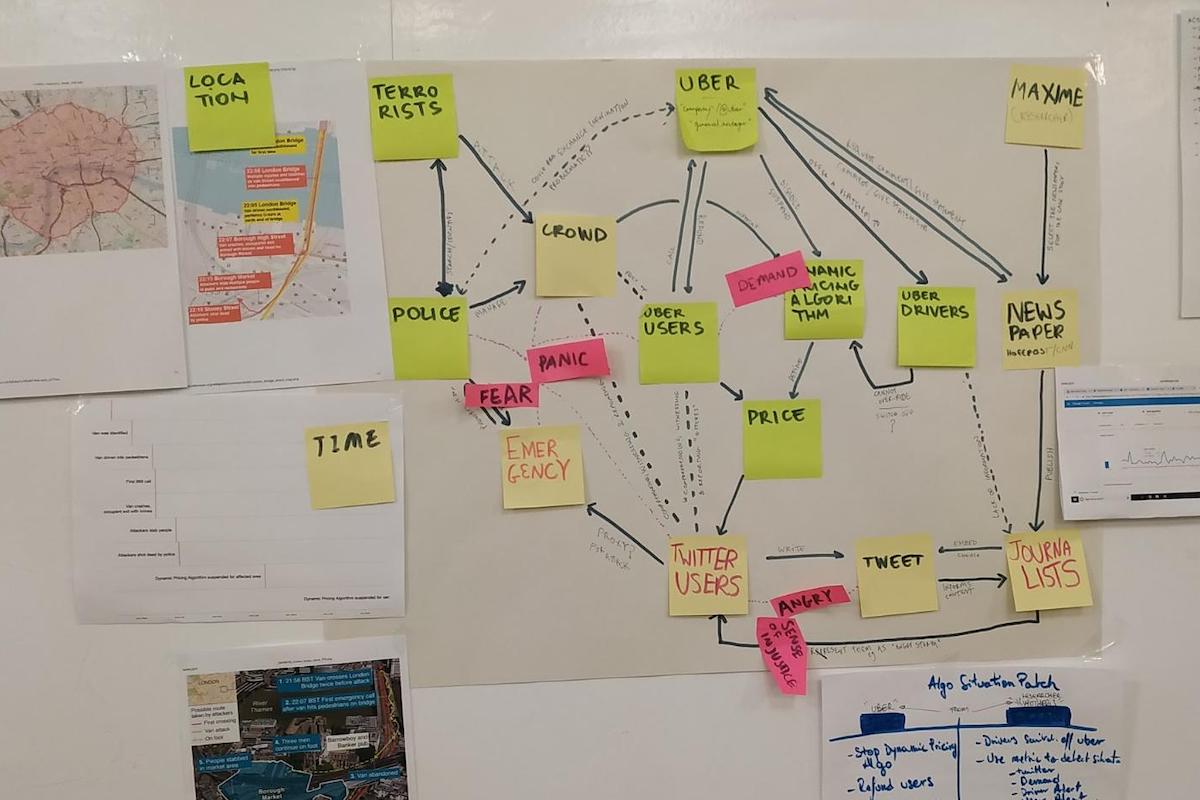Affiliation: King's College London
Jose Miguel Monteiro Vieira
Mapping the Politics of Nature-Based Solutions

Over the past decade “nature-based solutions” have risen to prominence as part of international commitments to addressing different kinds of societal issues and public problems including climate change, biodiversity loss, well being, disaster reduction and economic development.
In this collaborative digital methods project we gather and repurpose online materials associated with “nature-based solutions” on a variety of platforms and online spaces in order to understand more about the origins, development and politics of this term.
The project included a series of workshops with campaigners and investigators from Global Witness, researchers from the departments of Geography and Digital Humanities at King’s College London and DensityDesign Lab at the Politecnico di Milano. It received support from the Natural Environment Research Council (NERC).
For more about the project see:
- “Nature-based solutions”: using digital methods to investigate corporate greenwashing, Global Witness, 12th July 2022
- Fossil fuel greenwash, Global Witness, 15th February 2023
- Querying nature-based solutions – “These cards are an invitation to query and re-index Google search results for ‘nature-based solutions’, looking beyond more prominent promotional narratives to surface concerns, questions, tensions and uncertainties with advocating nature as solution. Each card contains a critical quote together with its original search position and source.”
Maud Borie
Anna Smith
Profiling Bolsobot Networks

How to capture the operation of political bots networks? Which types of accounts compose bot ecologies? How do bots promote content? To what extent do platform moderation policies impact bots’ activities over time? How does inauthentic activity change as content moderation measures refine their capture of bots and other “platform manipulations”? This project gathers and profiles accounts operating in Brazilian online political debates through the use of quali-quantitative methods. It investigates the activities of pro- and anti- president Jair Bolsonaro bots across platforms (i.e. Instagram, Twitter and TikTok) to make “inauthentic” behaviour visible, as well as addressing challenges of studying networked disinformation environments.
The project explores methodological approaches for studying inauthentic behaviour online that moves beyond bot detection towards an analysis of their vernacular, collective strategies and particularities. The project aims to produce a series of research reports on “bolsobots”, their networks and digital methods recipes to understand their social lives.
For more details see: Omena, J. J., Lobo, T., Tucci, G., Bitencourt, E., de Keulenaar, E., Kerche, F., Chao, J., Liedtke, M., Li, M., Paschoal, M. L., & Lavrov, I. (2024). Quali-quanti visual methods and political bots: A cross-platform study of pro- & anti-bolsobots. Journal of Digital Social Research, 6(1), 50-73. https://doi.org/10.33621/jdsr.v6i1.215
Reports
- Profiling Bolsobots Networks. A quali-quanti approach to repurpose Instagram grammars. Digital Methods Initiative.
- After all, what are bolsobots like these days? #SMARTDataSprint.
- Insta Bots and the black market of social media engagement, Janna Joceli Omena.
- Disinformation and inauthencity in ONU Brasil’s social media spheres, Emillie de Keulenaar.
- Reading Digital Networks: Climate Emergency, Bolsonaro & Bot Image Circulation by Vision API, Janna Joceli Omena.
- Profiling Bolsobot Networks, blog report cross-posted on Public Data Lab blog and CIM blog.
Articles
- Robôs e desinformação nas redes: O que já se sabe nas eleições 2018. Nexo Jornal.
- When Machine Behavior Targets Future Voters: The Use of Social Bots to Test Narratives for Political Campaigns in Brazil. International Journal of Communication, 15(0), 1220–1223.
- Omena, J. J., Lobo, T., Tucci, G., Bitencourt, E., de Keulenaar, E., Kerche, F., Chao, J., Liedtke, M., Li, M., Paschoal, M. L., & Lavrov, I. (2024). Quali-quanti visual methods and political bots: A cross-platform study of pro- & anti-bolsobots. Journal of Digital Social Research, 6(1), 50-73. https://doi.org/10.33621/jdsr.v6i1.215
East and Southeast Asians: Documenting a Category in the Making

In collaboration with organisations involved in its development and promotion, the aim of this project is to critically document and analyse the making of a new collective ethnic identifier in the United Kingdom: “East and Southeast Asian” (ESEA).
The term ESEA has emerged relatively recently in the UK, coming to prominence since 2018. This term is typically used as a bottom-up collective ethnic identifier for communities who originate from, or have ties to, East and Southeast Asia. Increasingly, it also functions as means of categorising communities to secure political recognition and representation.
Ethnic and racial categories are crucial yet contested components of modern societies. These categories are often essential for tracking the presence of minority groups within a polity and ensuring their representation and inclusion in formal politics and institutional settings. But such categories can also be instruments of exclusion – particularly if they mis-represent the groups they’re supposed to encompass. Indeed, communities often also form in resistance to the very mechanisms of categorisation.
In the past few years, a number of different activist groups and civil society campaigns have begun to use ESEA for at least three key reasons:
- In solidaristic response to the intensification of anti-Asian racism and violence spurred by the COVID-19 pandemic, and racism against BIPOC highlighted by BLM;
- To campaign for the institutional inclusion of ESEA communities (In the UK, the word “Asian” typically refers to people of South Asian origin); and
- As a form of political community-building.
The emergence of this term provides us with a rare opportunity to study a collective ethnic identifier in the making. Using digital methods and approaches derived from critical code race studies, we hope to produce research outcomes that our collaborating organisations can use in their advocacy work, while also producing a better understanding of how and why such collective community identifiers emerge and how they come to be institutionalised as categories.
For more on this project see:
- Personalisation in the expanded field post on People Like You project blog
- Workshop series with ESEA Hub
- Who and what is East and South East Asian Heritage Month for? published with bese.an
- Wikipedia Editathon on “East and Southeast Asians in the UK”, 15th September 2022 (cross-posted on ESEA Hub and King’s DDH)
Wing-Fai Leung
A Field Guide to Algorithms

What are algorithms? Who and what do they involve? What do they do? What is at stake with them? How can we account for them? How can we respond to them?
Following on from the Field Guide to “Fake News”, A Field Guide To Algorithms aims to gather and curate different starting points, recipes, approaches, experiments in participation and activities for collective inquiry into algorithms and the collectives, cultures, infrastructures, imaginaries and practices associated with them.
See also:
Atmospheres of Denial

This project explores digital cultures of climate change denial in collaboration with DeSmog and taking their Global Warming Disinformation Database as a starting point.
Image from “engaged research-led teaching” project undertaken with DeSmog, researchers and students at the Department of Digital Humanities, King’s College London.